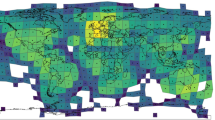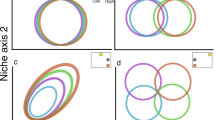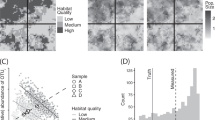Abstract
For more than a century ecologists have sought to explain the spatial heterogeneity of plants and animals1, but progress has been hampered by measurement bias2. A measure thought to be an unbiased index of spatial heterogeneity3 is b, the fitted exponent in the empirical relationship s2 = aMb, where sa2 is the variance and M the average of randomly placed replicate population estimates4. This index is widely accepted because of the impressive correlation between s2 and M and because it requires no inter-organism distance measures. Theoretical models, based on migratory behaviour5 or demographic factors6, have been proposed to account for the relationship between s2 and M. These models disagree regarding the effect of environment on b and the divergence of b values shown by different species. Here I report data showing that species-specific b varies among environments and that different species often show similar b values, favouring the demographic model. Analysis of these data shows that different levels of replication and sampling coverage lead to biased b values, casting doubt on the use of b for the deduction of cause of spatial variance relationships or the comparative measurement of spatial heterogeneity.
This is a preview of subscription content, access via your institution
Access options
Subscribe to this journal
Receive 51 print issues and online access
$199.00 per year
only $3.90 per issue
Buy this article
- Purchase on Springer Link
- Instant access to full article PDF
Prices may be subject to local taxes which are calculated during checkout
Similar content being viewed by others
References
Lussenhop, J. J. Hist. Biol. 7, 319–337 (1974).
Green, R. H. Res. Pop. Ecol. 8, 1–7 (1966).
Taylor, L. R. A. Rev. Entomol. 29, 321–357 (1984).
Taylor, L. R., Woiwod, I. P. & Perry, J. N. J. Anim. Ecol. 47, 383–406 (1978).
Taylor, L. R., Taylor, R. A. J., Woiwod, I. P. & Perry, J. N. Nature 303, 801–804 (1983).
Anderson, R. M., Gordon, D. M., Crawley, M. J. & Hassell, M. P. Nature 296, 245–248 (1982).
Taylor, L. R. in Statistical Ecology Vol. 1 (eds Patil, G. P., Pielou, E. C. & Waters, W. E.) 357–372 (Pennsylvania University Press, 1969).
Taylor, L. R. & Taylor, R. A. J. Nature 265, 415–420 (1977).
Taylor, R. A. J. J. Anim. Ecol. 50, 573–586 (1981).
Taylor, R. A. J. J. Anim. Ecol. 50, 587–604 (1981).
Hanski, I. Ann. Zool. Fennici 19, 21–37 (1982).
Bartlett, M. S. Stochastic Population Models in Ecology and Epidemiology (Methuen, London, 1960).
May, R. M. Stability and Complexity in Model Ecosystems (Princeton University Press, 1973).
Tayor, L. R., Woiwod, I. P. & Perry, J. N. J. Anim. Ecol. 49, 831–854 (1980).
Taylor, L. R. & Woiwod, I. P. J. Anim. Ecol. 51, 879–906 (1982).
Taylor, L. R. Nature 189, 732–735 (1961).
Dumont, H. J. Mem. Ist. Ital. Idrobiol. 22, 81–103 (1967).
Dumont, H. J. Hydrobiologia 32, 97–130 (1968).
Beall, G. Biometrika 30, 422–439 (1938).
Harcourt, D. G. Can. Ent. 95, 813–820 (1963).
Koss, R. W., Jensen, L. D. & Jones, R. D. in Environmental Responses to Thermal Discharges from Marshall Steam Station (ed. Jensen, L. D.) 173–186 (Electric Power Research Institute, Palo Alto, California, 1973).
Hiltunen, J. Limnological data from Lake St Clair, 1963 and 1965 (NOAA-USA data report No. 54, 1971).
LaPerriere, J. D. Evaluation of the Trophic Types of Several Alaskan Lakes by Assessment of the Benthic Fauna Report IWR-63 (Alaskan Institute of Water Resources, Fairbanks, 1975).
Fleming, W. E. J. agric. Res. 53, 319–331 (1936).
Harcourt, D. G. Can. Ent. 93, 945–952 (1961).
Kobayashi, S. Res. Pop. Ecol. 7, 109–117 (1965).
McGuire, J. U., Brindley, T. A. & Bancroft, T. A. Biometrics 13, 65–78 (1957).
Meyers, M. T. & Patch, L. H. J. agric. Res. 55, 849–871 (1937).
Cain, S. A. & Evans, F. C. Cont. Lab. Vert. Biol. Univ. Mich. 52, (1952).
Cassie, R. M. N.Z. J. Sci. 3, 26–50 (1960).
Langeland, A. & Rognerud, S. Arch. Hydrobiol. 73, 403–410 (1974).
Langford, R. R. & Jermolajev, E. G. Verh. Internat. Verein. Limnol. 16, 188–193 (1966).
Malone, B. J. & McQueen, D. J. Hydrobiologia 99, 101–124 (1983).
McGowan, J. A. & Fraundorf, V. J. Limnol. Oceanogr. 11, 456–469 (1966).
Mori, S. Mem. Fac. Sci., Kyoto Univ. 1, 78–94 (1967).
Paterson, C. G. & Walker, K. F. Aust. J. mar. Freshwater Res. 25, 151–165 (1974).
Winsor, C. P. & Clarke, G. L. J. mar. Res. 3, 1–34 (1940).
Guest, P. G. Numerical Methods of Curve Fitting (Cambridge University Press, 1961).
Ricker, W. E. J. Fish Res. Board Can. 30, 409–434 (1973).
Prepas, E. E. in A Manual on Methods for the Assessment of Secondary Productivity in Fresh Waters (eds Downing, J. A. & Rigler, F. H.) 266–335 (Blackwell, Oxford, 1984).
Steel, R. G. D. & Torrie, J. H. Principles and Procedures of Statistics (McGraw-Hill, New York, 1960).
Author information
Authors and Affiliations
Rights and permissions
About this article
Cite this article
Downing, J. Spatial heterogeneity: evolved behaviour or mathematical artefact?. Nature 323, 255–257 (1986). https://doi.org/10.1038/323255a0
Received:
Accepted:
Issue Date:
DOI: https://doi.org/10.1038/323255a0
This article is cited by
-
Spatial and dynamic distribution of Chrysoperla spp. and Leucoptera coffeella populations in coffee Coffea arabica L
Precision Agriculture (2024)
-
Macroecological dynamics of gut microbiota
Nature Microbiology (2020)
-
Mapping Azteca barbifex Forel (Hymenoptera: Formicidae) dispersal in georeferenced orange (Citrus sinensis [L.] Osbeck) orchard in the Eastern Amazon, Brazil
Insectes Sociaux (2018)
-
Taylor’s Law improves the accuracy of bioassessment; an example for freshwater macroinvertebrates
Hydrobiologia (2015)
-
Sample size in the monitoring of benthic macrofauna in the profundal of lakes: evaluation of the precision of estimates
Hydrobiologia (1996)
Comments
By submitting a comment you agree to abide by our Terms and Community Guidelines. If you find something abusive or that does not comply with our terms or guidelines please flag it as inappropriate.



